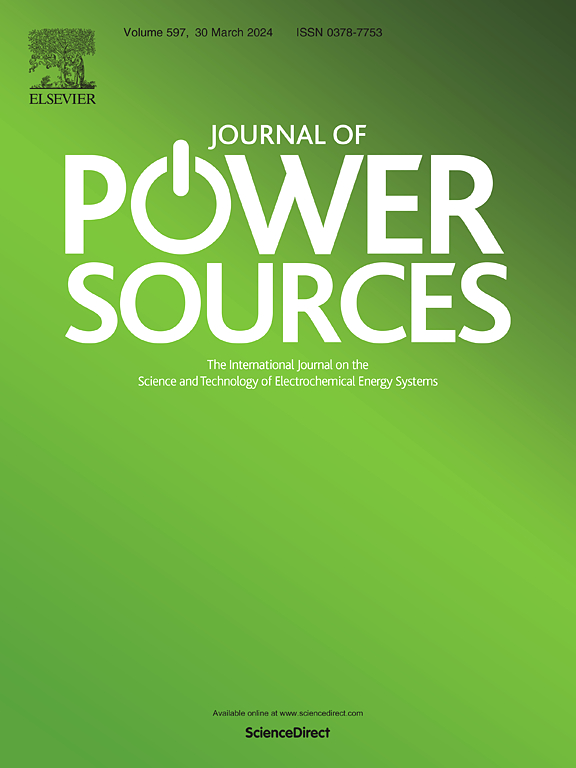IF 8.1
2区 工程技术
Q1 CHEMISTRY, PHYSICAL
引用次数: 0
摘要
采用共轭聚合物(CPs)的电致变色-超级电容器器件(ESDs)在多功能性和灵活性方面具有卓越的优势,这对于开发多功能和可穿戴电子设备至关重要。然而,在制备基于 CPs 的 ESD 时,如何实现成本效益和高性能仍然是一个相当大的挑战。在本文中,我们介绍了一种利用共轭聚合物双网络 (CPDN) 的新型设计策略,特别是将聚(3,4-亚乙二氧基噻吩)(PEDOT)和聚苯胺(PANI)整合在一起。该策略包括合成双目标交联前体,然后通过一步式低电位电化学聚合反应聚合成 CPDN。所获得的聚合物具有出色的电致变色和电容性能,其特点是切换时间快(约 1 秒)、着色效率(CE)值高(322 cm2 C-1)、光学对比度强(610 纳米波长下为 41%)、比电容大(1 A g-1 时为 357 F g-1)。利用这种 CPDN 制作的柔性经济型 ESD 在掺杂(充电)和除掺(放电)过程中显示出黄色和紫色之间的可逆颜色转换,在 1000 次循环后保持 86.4% 的稳定性。这一特性有助于通过视觉颜色变化对静电放电中的储能水平进行智能监控。因此,所提出的聚合物复合材料有望为柔性静电放电提供一种基于氯化石蜡的创新候选材料。本文章由计算机程序翻译,如有差异,请以英文原文为准。
Merging PEDOT and polyaniline for cost-effective yet high performance flexible electrochromic-supercapacitor dual device
Electrochromic-supercapacitor devices (ESDs) employing conjugated polymers (CPs) display elegant advantages in versatility and flexibility, which are essential for the development of multifunctional and wearable electronic devices. However, achieving both cost-effectiveness and high performance remains a considerable challenge in the preparation of CPs-based ESDs. Herein, we introduce a novel design strategy utilizing a conjugated polymer dual network (CPDN), specifically integrating poly(3,4-ethylenedioxythiophene) (PEDOT) and polyaniline (PANI). This strategy involves the synthesis of a dual-target crosslinked precursor, followed by polymerized into a CPDN via one-step, low-potential electrochemical polymerization. The obtained polymer exhibits excellent electrochromic and capacitive performances, characterized by fast switching time (about 1 s), a high coloring efficiency (CE) value (322 cm2 C−1), a robust optical contrast (41 % at 610 nm), and an impressive specific capacitance (357 F g−1 at 1 A g−1). The fabricated flexible and economical ESDs by this CPDN demonstrate a reversible color transition between yellow and purple during the doping (charging) and dedoping (discharging) processes, maintaining 86.4 % stability after 1000 cycles. This feature facilitates the intelligent monitoring of energy storage levels in ESDs by visual color changes. The proposed polymer composite is therefore expected to provide an innovative CPs-based candidate for flexible ESDs.
求助全文
通过发布文献求助,成功后即可免费获取论文全文。
去求助
来源期刊

Journal of Power Sources
工程技术-电化学
CiteScore
16.40
自引率
6.50%
发文量
1249
审稿时长
36 days
期刊介绍:
The Journal of Power Sources is a publication catering to researchers and technologists interested in various aspects of the science, technology, and applications of electrochemical power sources. It covers original research and reviews on primary and secondary batteries, fuel cells, supercapacitors, and photo-electrochemical cells.
Topics considered include the research, development and applications of nanomaterials and novel componentry for these devices. Examples of applications of these electrochemical power sources include:
• Portable electronics
• Electric and Hybrid Electric Vehicles
• Uninterruptible Power Supply (UPS) systems
• Storage of renewable energy
• Satellites and deep space probes
• Boats and ships, drones and aircrafts
• Wearable energy storage systems
 求助内容:
求助内容: 应助结果提醒方式:
应助结果提醒方式:


